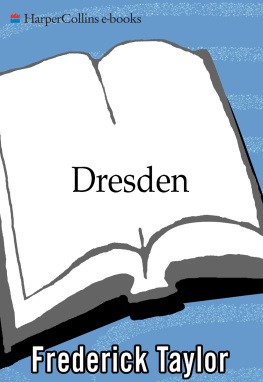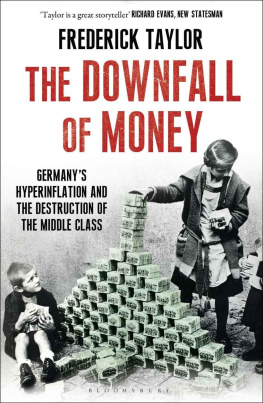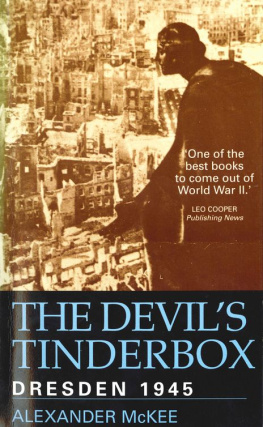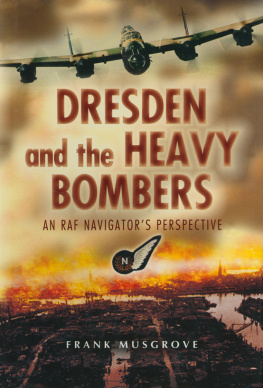Frederick Taylor
Dresden
Tuesday, February 13, 1945

To Alice
How lonely lies the city that was full of people. All her gates are desolate. The holy stones lie scattered at the head of every street. From on high He sent fire, into my bones He made it descend. Is this the city that was called the perfection of beauty, the joy of the earth?
She took no thought of her doom; therefore her fall is terrible, she has no comforter. For this our heart has become sick, for these things our eyes have grown dim.
Why do you forget us forever, why do you so long forsake us? Restore us to your self, O Lord, that we may be restored. Renew our days of old, O Lord, behold my affliction, O Lord, and behold my distress!
L AMENTATIONS OF J EREMIAH , 1, 1, 14, 13; 2, 15; 1, 9; 5, 17, 2021; 1, 9
Wie liegt die Stadt so wst, die voll Volks war. Alle ihre Tore stehen de. Wie liegen die Steine des Heiligtums vorn auf allen Gassen zerstreut. Er hat ein Feuer aus der Hhe in meine Gebeine gesandt und es lassen walten. Ist das die Stadt, von der man sagt, sie sei die allerschnste, der sich das ganze Land freuet?
Sie htte nicht gedacht, dass es ihr zuletzt so gehen wrde; sie ist ja greulich heruntergestossen und hat dazu niemand, der sie trstet. Darum ist unser Herz betrbt, und unsre Augen finster geworden.
Warum willst Du unser so gar vergessen und uns lebenslang so gar verlassen? Bringe uns, Herr, wieder zu dir, dass wir wieder heimkommen. Erneue unsre Tage wie vor alters. Herr, siehe an mein Elend, ach Herr, siehe an mein Elend!
K LAGELIED J EREM . 1, 1, 14, 13; 2, 15; 1, 9; 5, 17, 2021; 1, 9
Verses from Luthers translation of the Bible, arranged in: Funeral Motet for mixed choir a cappella: Wie Liegt die Stadt so Wst. Introduction to the Dresden Requiem by Rudolf Mauersberger (18891971).
Contents
Saxons
Florence on the Elbe
Blood and Treasure
The Twin Kingdom
Florence on the Elbe
The Last King of Saxony
The Saxon Mussolini
A Pearl with a New Setting
First the Synagogue Burns, Then the City
Laws of the Air
Call Me Meier
Blitz
Fire and the Sword
The Reichs Air Raid Shelter
A City of No Military or Industrial Importance?
Total War
Ardennes and After
Thunderclap and Yalta
Intimations of Mortality
Time and Chance
Shrove Tuesday
Tally-Ho!
Air Raid Shelter the Best Protection
The Perfect Firestorm
Catastrophe
Ash Wednesday
Aftermath
After the Fall
City of the Dead
Propaganda
The Final Fury
The War Is Over. Long Live the War
The Socialist City
The Sleep of Reason
Commemoration
The Massacre on the Elbe Meadows
Counting the Dead
Legends of the Fall
WHEN THE FACTS become the legend, print the legend! So says Dutton Peabody, the cynical newspaperman in the classic Western movie The Man Who Shot Liberty Valance .
As a student in the 1960s, I knew only the legend of Dresden, because it was just about all that was ever printed. Like so many others of my age, I had learned of the citys destruction principally through a work of fiction: Kurt Vonneguts acidly surreal masterpiece, Slaughterhouse-Five. A brilliant novel, written partly from the perspective of his own grim personal experiences as a prisoner of war who shared the citys fatebut a figment of the imagination nonetheless.
For thirty years Vonneguts bestselling workand books by David Irving and Alexander McKeesufficed to describe the catastrophic air raid on Dresden in February 1945, which for most readers in the English-speaking world and elsewhere came to represent not just the savage apogee of the conventional bombing war but something far worse: a senseless crime. The message these works conveyed for us, the next generation in Britain and the United States, was one of almost entirely unmitigated shame. Dresden was the unforgivable thing our fathers did in the name of freedom and humanity, taking to the air to destroy a beautiful and, above all, innocent European city. This was the great blot on the Allies war record, the one that could not be explained away.
Perhaps there were always parts of the legend that didnt ring entirely true. The vast casualty figures citedrising into the hundreds of thousandsso much more horrifying than the consequences of any other conventional air raid, and greater, some claimed, than the numbers killed at Hiroshima or Nagasaki. The notion that Dresden, a city of almost three-quarters of a million hardworking human beings in one of the oldest-established industrial regions of Europe, concerned itself only with harmless cultural pursuits and the making of luxury goods and china, even in the middle of the Nazi regimes self-proclaimed Total War. The almost complete lack, wherever one looked, of any background information on the city, its political passions, economic problems and social anxieties: its ugly and intolerant aspects, which must be considered along with its beautiful, cultured side.
Part of the problem was always that, less than three months after its destruction, Dresden exchanged one set of totalitarian masters for another, when the Communists replaced the Nazis. What records remained after 1945 of the citys former life were less than fully open to scholars and investigators, and most of its surviving people kept the silence of official conformity. Versions of what happened between ten P.M . on the night of February 13, 1945, and noon on February 14, 1945many originating from the fertile brain of Hitlers propaganda minister, Josef Goebbelsbecame set in cold-war stone, and further reexamination of the circumstances was not encouraged by a communist government eager to blacken the names of the Western Allies. The liberating moment came in 1989, with the collapse of the Soviet Union and the end of communism in East Germany. At last the people of Dresden could write, discuss, and access their collective memory without hindrance or fear of official persecution, and so could outside scholars and investigators.
The most objective work previously available concerning the destruction of Dresden has all been in German. Gtz Bergander, Dresden-born and a teenage witness of the bombing, later a radio journalist and writer based in Berlin, wrote his book Dresden im Luftkrieg (Dresden in the Air War) in the 1970s and after 1989 revised it extensively in the light of the new information becoming available. Scandalouslyconsidering the heedlessness with which apocalyptic legends of Dresdens fall continue to be printed in the English-speaking worldHerr Berganders scrupulous, rich, and fascinating account of the attacks on his home city has never been translated into English. Likewise in the case of another Dresden historian, Matthias Neutzner, whose books Lebenszeichen (Signs of Life) and Martha Heinrich Acht (Martha Heinrich EightDresdens code name on the German air defense grid) manage the almost impossible task of setting Dresdens destruction in wartime perspective while at the same time heightening to an all but unbearable level of intensity the tragic human loss it involved.
It was after I read these books, and came into contact with their authors, that my own journey began. The journey was, of course, a physical one: to Dresden and Berlin and London and Washington to consult records and documents; from an RAF veterans cottage in Norfolk to a former slave laborers house on the edge of the Bavarian forest; from interviews with Dresdens survivors in hotel rooms to emotional conversations in neat apartments built on the very rubble of the districts where eye-witnesses had grown up. It was also, however, a mental journey, confronting evidence that did not fit my old idea of what Dresden had been, and forcing myself to see the wartime years, not through the eyes of the pacifistically inclined baby-boomer I had been and remain, but as it might have been regarded by those who lived and fought, suffered and struggled at the time, when the future was unknown and thousands of innocents were still dying every day.












